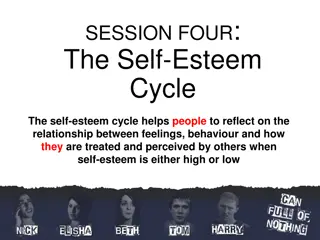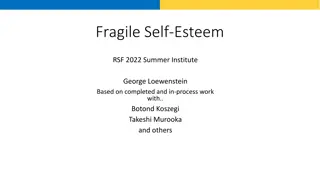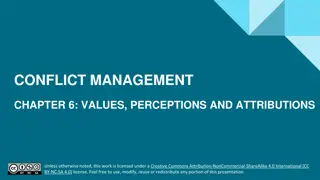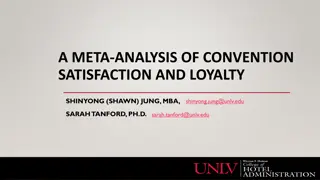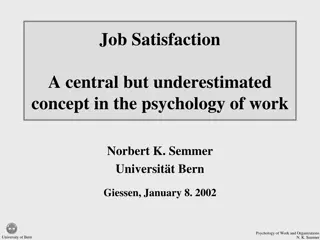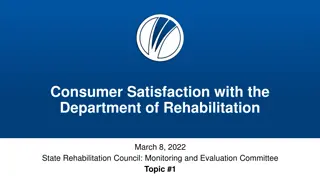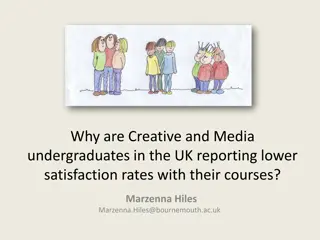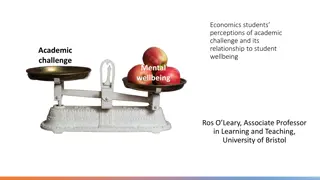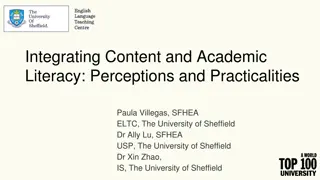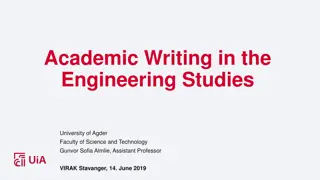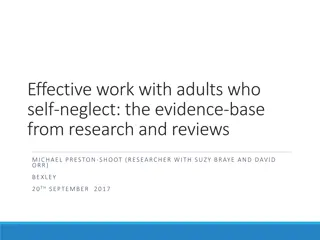Exploring the Relationship Between Academic Satisfaction and Self-Perceptions of Learning
Discussing the interplay between academic satisfaction and self-perceptions of learning, this study by Steve Graunke from Indiana University-Purdue University Indianapolis delves into models and statistical analyses using the IUPUI Continuing Student Survey. Examining how these constructs relate, the study investigates the implications of reciprocal causation, comparing models where satisfaction predicts perceptions or vice versa.
Download Presentation

Please find below an Image/Link to download the presentation.
The content on the website is provided AS IS for your information and personal use only. It may not be sold, licensed, or shared on other websites without obtaining consent from the author.If you encounter any issues during the download, it is possible that the publisher has removed the file from their server.
You are allowed to download the files provided on this website for personal or commercial use, subject to the condition that they are used lawfully. All files are the property of their respective owners.
The content on the website is provided AS IS for your information and personal use only. It may not be sold, licensed, or shared on other websites without obtaining consent from the author.
E N D
Presentation Transcript
SATISFACTION AND SELF-PERCEPTIONS: HOW ARE THE RELATED? STEVE GRAUNKE INDIANA UNIVERSITY-PURDUE UNIVERSITY INDIANAPOLIS
PRESENTATION Discuss the relationship between academic satisfaction and self- perceptions of learning Explore a model of academic satisfaction and self-perceptions of learning using the IUPUI Continuing Student Survey Demonstrate statistical model features in Mplus (that SPSS and SAS can t do as well) Discuss implications
BACKGROUND Academic Satisfaction Indirect assessment
ACADEMIC SATISFACTION Edwards and Waters (1982) Satisfaction and GPA predict persistence Schreiner (2009) Comprehensive study of satisfaction and retention Pullins (2011) Sophomore students Satisfaction with Campus Climate Advising
INDIRECT ASSESSMENT Direct Assessment demonstrations of skills Indirect Assessment Feelings about learning Perceptions of abilities
HOW THESE CONSTRUCTS RELATED? Student- Faculty interaction Grades Academic Persistence
RECIPROCAL CAUSATION BETWEEN SATISFACTION AND PERFORMANCE Work organization literature Suggests satisfied employees perform better (and vise versa) Bean & Bradley (1986) Based on organizational literature Satisfaction stronger Pike (1991) Reciprocal causation model between grades and satisfaction fits well Satisfaction wins
CURRENT STUDY Does reciprocal causation better describe the relationship between academic satisfaction and self-perceptions of learning than models in which academic satisfaction predicts self-perceptions (or self-perceptions predicts academic satisfaction)?
IUPUI CONTINUING STUDENT SURVEY Multipurpose survey Overall Academic Satisfaction = 0.813 Overall, how satisfied are you with your academic experiences at IUPUI? How satisfied are you with the quality of the academic programs at IUPUI? Principles of Undergraduate Learning Indirect Assessment Communication Skills (4 items) Quantitative Skills (4 items) Exponent transformation
LATENT VARIABLES Variables that are not observed directly Example: Socio-economic status Indicators Accounts for measurement error Advantages More consistent parameter estimates Large samples Disadvantages May need more complicated software to do this
THE LATENT VARIABLE PART Formally communicate ideas and information (oral, visual, aural, etc.) (n802) Write a final report on a project or other work assignment (n803) Communicate with a team to solve problems (n804) Read and understand books, articles, and instruction manuals (n801) Solve mathematical problems (n805) Support an argument using quantitative data (n808) Use mathematics in everyday life (n806) Understand a statistical report (n807)
STUDY 521 Senior respondents 3 Exogenous observed variables Gender (65% female) IU Cumulative GPA STEM major Structural Equation model
MODEL 1/ SATISFACTION PREDICTS SELF- PERCEPTIONS n801 IU Cumulative GPA n802 Academic Satisfaction Comm. skills Gender (Flag for female) n803 n804 STEM major n805 Quant. skills n806 n807 n808
MODEL 2/ SELF- PERCEPTIONS PREDICT SATISFACTION n801 IU Cumulative GPA n802 Academic Satisfaction Comm. skills n803 Gender (Flag for female) n804 STEM major n805 Quant. skills n806 n807 n808
MODEL 3/ RECIPROCAL CAUSATION n801 IU Cumulative GPA n802 Academic Satisfaction Comm. skills n803 Gender (Flag for female) n804 STEM major n805 Quant. skills n806 n807 n808
MODEL ESTIMATION Maximum Likelihood estimation (ml) Enables clearer comparisons between models Chi-square difference test 2 1 2 = improvement in model fit 0
DESCRIPTIVE STATISTICS FOR OBSERVED VARIABLES Variables N Mean 4.01 1.43 1.42 1.42 1.42 1.37 1.37 1.34 1.38 0.65 3.18 0.29 Variance 0.586 0.008 0.008 0.009 0.007 0.013 0.013 0.013 0.012 0.227 0.315 0.207 521 521 520 521 521 521 521 521 521 521 521 521 Satisfaction with overall academic experiences a Read and understand books, articles, and instruction manuals b Formally communicate ideas and information (oral, visual, aural, etc.) b Write a final report on a project or other work assignment b Communicate with a team to solve problems b Solve mathematical problems b Use mathematics in everyday life b Understand a statistical report b Support an argument using quantitative data b Gender (Flag for Female) GPA STEM major a Scale for included items: 1 = Very Dissatisfied, 2= Dissatisfied, 3= Neutral, 4= Satisfied, 5= Very Satisfied b Scale: 1 = Not at all Effective, 2= Somewhat Effective, 3= Effective, 4= Very Effective. Exponent transformation used on these items. Means and variance account for transformation.
MODEL FIT STATISTICS Null model 2180.2 63 -- -- -- Model 1 Model 2 Model 3 Chi-Square Dof RMSEA CLI TLI 92.3 46 0.044 0.978 0.970 94.5 46 0.045 0.977 0.969 89.2 44 0.044 0.979 0.969
RESULTS All models fit data Satisfaction does impact self-perceptions Self-perceptions do impact satisfaction Not statistically significant improvement Significant effects
SO WHAT AM I GOING TO DO WITH THIS? What interventions effect both satisfaction and self-perceptions? Four page Research Brief Other factors?
FOR MORE INFORMATION ON SEM AND MPLUS Byrne, B. M. (2012). Structural equation modeling with Mplus. New York, NY: Routledge. Any Questions?






